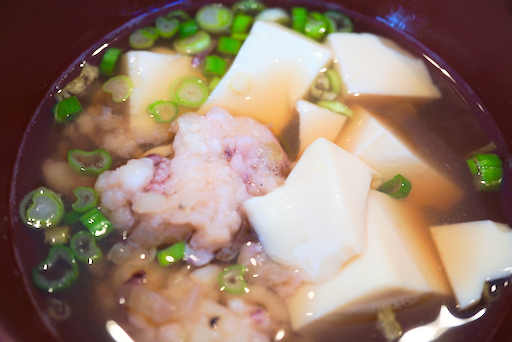This recipe is from "
The real Japanese Izakaya Cookbook". This dish is featured on the cover. I ended up, by necessity, having to modify the recipe. Despite the modification, this dish turned out to be very good. I served it, as per my wife's suggestion, with a wedge of lemon rather than "Japanese sauce" as the original recipe suggested. I served it with my usual sugar snaps and Campari tomato.
Since the squid legs were only coarsely chopped, you can see them in the cut surface which gave texture to this dish.
Actually, I made a soup using the squid mixture as per the original recipe. As I dropped the mixture into the broth, I realized the squid balls were not sticking together as well as I expected. For the soup, this was not much of a problem but I did not want the squid balls to fall apart in the hot oil. So, I had to modify the recipe by adding more "binders"(egg, more flour and panko bread crumbs).
This clear soup was made of dashi from my usual dashi pack, sake, mirin and light colored soy sauce. I made "quenelles" using two teaspoons and dropped them into the simmering soup. They did not maintain a quenelle shape but mostly stayed together. I added silken tofu and chopped scallion to the soup. Just before serving, I added frozen "yuzu" skin to the soup bowls. Despite the fact the squid mixture became a rather amorphous blob this was a pretty good soup.
The squid balls in the soup were based on the original recipe. When I saw how they cooked in the soup I realized I had to alter the recipe to make sure they did not dissolve when I put them in the hot oil. The instructions below are for the squid fritters and include my modifications.
Ingredients (This is my modification):
1lb cleaned squid, tentacles and body, half and half (the body hand chopped into small pieces , #1 and the tentacles cut into small chunks, #2).
2-3 tbs Panko Japanese bread crumbs
1 egg
2 tbs flour
1/2 tsp salt
1/4 tsp black pepper
For frying
Flour, egg+water, panko
Peanut oil for deep frying
Directions:
Mix all ingredients well and make small oval patties. Usual frying process; dredge in flour, dip in egg water, and coat with panko crumbs (#3)
Deep fry for 4-5 minutes turning occasionally (maybe because of the egg, the fritters puffed up into a ball (#4)
I think the reason I had to add more binders (flour, bread crumb and egg) is because the body of the squid was not chopped finely enough (to paste). Next time I will use a small food processor and make it more the consistency of mousse. It is not easy to hand chop squid.
In any case, the end result was pretty good. We think just lemon is better than Japanese Worcestershire sauce for these rather delicate tasting squid fritters. During the week we heated up the remaining fritters in the toaster oven for a week night appetizer and that worked out very well.
My wife found the daffodils in the front yard with large buds on them. She brought two inside and put them in a Japanese style flower vase. A few days later it bloomed beautifully. Spring is coming!
































